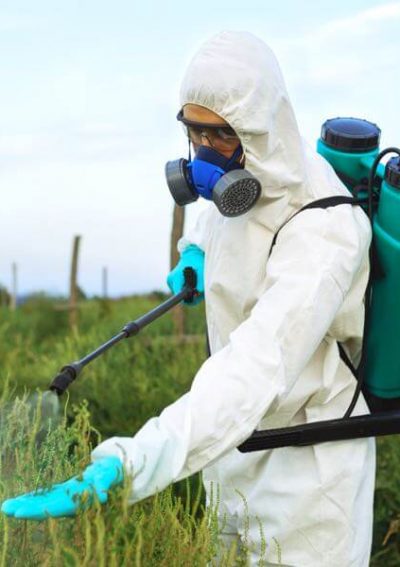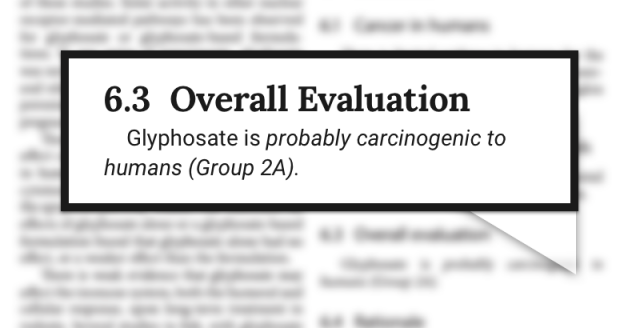Roundup and Cancer
More than 9.4 million tons of Roundup and other glyphosate-based herbicides have been used to kill weeds around the world since 1974. About two-thirds of that has been sprayed just since 2004. Bayer and Monsanto, Roundup’s manufacturers, say the product line is safe. But a growing number of people who’ve worked with it blame glyphosate for causing cancer.

International regulators and researchers disagree on whether Roundup and other glyphosate-based herbicides increase the risk of cancer.
Studies of cancer rates in people exposed to glyphosate have returned conflicting results, according to the National Pesticide Information Center. But the center says some studies have associated glyphosate-based herbicides with non-Hodgkin lymphoma.
Research into an association between glyphosate and cancer in humans is very limited. Studies have shown large doses of the chemical may cause cancer in animals. But results from animal tests don’t always translate to the same results in humans.
Drug and chemical giant Bayer AG acquired Roundup’s original manufacturer, Monsanto, in 2018. Bayer’s glyphosate website touts “more than 800 rigorous studies” on glyphosate conducted for United States, European and other regulators. It says these studies confirm glyphosate is not carcinogenic. But company emails from 2002 suggest no studies at that time had determined whether Roundup posed a cancer risk.
Cancer Risk Studies
A 2019 analysis published in the journal Mutation Research/Reviews in Mutation Research said evidence supports a link between exposure to glyphosate herbicides and a higher risk of non-Hodgkin lymphoma, a specific type of cancer.
The researchers conducted a meta-analysis of all published studies of glyphosate exposure in humans. They determined people who had been exposed to the largest amounts of the herbicide showed a 41 percent higher relative risk for the disease.

“Our current meta-analysis of human epidemiological studies suggests a compelling link between exposures to [glyphosate-based herbicides] and increased risk for [non-Hodgkin lymphoma],” the authors wrote.
The research included a fresh look at 2018 data from the government-funded Agricultural Health Study. Monsanto had used that study to argue there was no association between glyphosate and the disease.
“Our current meta-analysis of human epidemiological studies suggests a compelling link between exposures to [glyphosate-based herbicides] and increased risk for [non-Hodgkin lymphoma].”
The five United States researchers who wrote the 2019 analysis included three scientists who served on a 2016 Environmental Protection Agency advisory committee on glyphosate. The chief editor of the journal that published their work is also an EPA scientist.
The study’s findings differed sharply to those of other researchers who had examined Agricultural Health Study data just two years earlier.
A 2016 study in the British Medical Journal found only one cohort study had looked into a cancer association. Its results showed no apparent association between exposure and cancer risk. But the average follow-up time with participants in the study was 6.7 years, which is too short of a period to account for the time between initial exposure and when a doctor diagnoses cancer.
World Health Organization: Glyphosate ‘Probably Carcinogenic’
Following an extensive review of published research on glyphosate, the International Agency for Research on Cancer concluded in March 2015 that the herbicide is “probably carcinogenic.” The agency is part of the United Nations’ World Health Organization.

Its statement noted only “limited evidence” that glyphosate may cause cancer in humans. The agency said it based its decision on “sufficient evidence” that the chemical had caused cancer in tests on animals.
The agency had also looked at other research that had found strong evidence that glyphosate-based pesticides can damage genes. This is called genotoxicity and can lead to cancer.
The 2015 report stressed the amount of exposure and the way the chemical gets into the body play major roles in whether a person develops cancer.
Environmental Protection Agency’s Ongoing Assessment
The Environmental Protection Agency says Roundup and other glyphosate-based herbicides present “low toxicity” to humans, but the agency recommends people wait 12 hours before entering fields that have been treated with the chemical.
The EPA in 2021 said it found that glyphosate is “unlikely to be a human carcinogen.” The regulator recommends management measures such as targeting pesticides for specific pests, make weeds less resistant to glyphosate and protect plant pollinators.
“The agency’s assessment found no other meaningful risks to human health when the product is used according to the pesticide label,” the EPA said in a statement.
“The agency’s assessment found no other meaningful risks to human health when the product is used according to the pesticide label.”
But departments within the agency have disagreed over Roundup’s potential to cause cancer.
In 2015, the EPA’s Office of Pesticide Programs re-classified the weed killer as “not likely” to cause cancer. The agency’s Office of Research and Development questioned the decision. It recommended the Office of Pesticide Programs strengthen its human health assessment and explain why it came to a different conclusion than the International Agency for Research on Cancer.
European Food Safety Authority’s New Safe Exposure Levels
The European Food Safety Authority determined in November 2015 that glyphosate is “unlikely to pose a carcinogenic hazard to humans.” The regulatory body for the European Union examines and regulates pesticide use as part of its mission.
The agency’s conclusion came just eight months after the International Agency for Research on Cancer branded glyphosate as “probably carcinogenic.” The chief difference between the two reports is the UN agency considered the glyphosate association with non-Hodgkin lymphoma to have “limited evidence in humans” while in the EU assessment, most experts considered it “very limited.” The one word difference in descriptions was enough to prevent the European Food Safety Authority from declaring a cancer risk classification.
The European Food Safety Authority included the International Agency for Research on Cancer report in its research after the European Commission requested it look at the UN data.
“The evaluation considered a large body of evidence, including a number of studies not assessed by the [International Agency for Research on Cancer] which is one of the reasons for reaching different conclusions,” the European Food Safety Authority said in a news release.
All but one member of the panel that had examined glyphosate agreed that neither human nor animal studies showed a link between glyphosate exposure and cancer in humans. But the European agency did set new safe exposure levels for people who work around glyphosate or eat food that contains herbicide residue.
California Label Regulations
In 2017, California environmental regulators listed glyphosate as “known to the state to cause cancer.” The state’s Office of Environmental Health Hazard Assessment made the decision based in part on the report from the International Agency for Research on Cancer. State Proposition 65 requires the state office to add all substances the international agency deems carcinogenic to a state list of cancer-causing items.
The state office relies on several agencies to determine whether to add a substance to its carcinogenic warning list. The agency’s website says two other sources it relies on are in the process of reviewing glyphosate’s cancer risk. These are the Environmental Protection Agency and the National Toxicology Program, which is part of the United States Department of Health and Human Services.
The agency says several organizations have determined glyphosate is not likely to cause cancer. But it also says “scientific disagreement on the interpretation of data is not unusual and does not affect the listing.”
Agencies and Organizations that Have Found Glyphosate Does Not Cause Cancer
- United States Environmental Protection Agency (undergoing review)
- European Food Safety Authority
- European Chemicals Committee for Risk Assessment
- United Nations Food and Agriculture Organization/World Health Organization Joint Meeting on Pesticide Residues
California regulators went a step further, however. They also required all food products that contain traces of glyphosate to carry a warning label.
Large agriculture industry groups challenged the legality of the food warning labels. In February 2018, a federal judge temporarily blocked the labels.
Monsanto had also sued the state to remove glyphosate from the state’s warning list. But in April 2018, a federal appeals court said it could remain on the list.
24 Cited Research Articles
Consumernotice.org adheres to the highest ethical standards for content production and references only credible sources of information, including government reports, interviews with experts, highly regarded nonprofit organizations, peer-reviewed journals, court records and academic organizations. You can learn more about our dedication to relevance, accuracy and transparency by reading our editorial policy.
- Andreotti, G., et al. (2018, May 1). Glyphosate Use and Cancer Incidence in the Agricultural Health Study. Journal of the National Cancer Institute. Retrieved from https://www.ncbi.nlm.nih.gov/pubmed/29136183
- Baum, Hedlund, Aristei, Goldman PC. (2017, August 1). Monsanto Papers, Secret Documents (pg. 6). Retrieved from https://www.baumhedlundlaw.com/toxic-tort-law/monsanto-roundup-lawsuit/monsanto-secret-documents/page-six/
- Bayer. (2019, February 20). Glyphosate’s Impact on Human Health and Safety. All About Glyphosate. Retrieved from https://www.bayer.com/en/glyphosate-impact-on-human-health-and-safety.aspx
- Benbrook, C.M. (2016, February 2). Trends in Glyphosate Herbicide Use in the United States and Globally. Environmental Sciences Europe. Retrieved from https://enveurope.springeropen.com/articles/10.1186/s12302-016-0070-0
- California Office of Environmental Health Hazard Assessment. (2017, March 28). Glyphosate Listed Effective July 7, 2017, as Known to the State of California to Cause Cancer. Retrieved from https://oehha.ca.gov/proposition-65/crnr/glyphosate-listed-effective-july-7-2017-known-state-california-cause-cancer
- California Office of Environmental Health Hazard Assessment. (2018, March). Glyphosate and Proposition 65: Frequently Asked Questions. Retrieved from https://www.p65warnings.ca.gov/fact-sheets/glyphosate-and-proposition-65-frequently-asked-questions
- De Roos, A.J., et al. (2004, November 4). Cancer Incidence Among Glyphosate-Exposed Pesticide Applicators in the Agricultural Health Study. Environmental Health Perspectives. Retrieved from https://www.ncbi.nlm.nih.gov/pmc/articles/PMC1253709/
- European Food Safety Authority. (2015, November 12). Glyphosate: EFSA Updates Toxicological Profile. News Release. Retrieved from https://www.efsa.europa.eu/en/press/news/151112
- European Food Safety Authority. (n.d.). EFSA Explains Risk Assessment; Glyphosate. Factsheet. Retrieved from https://www.efsa.europa.eu/sites/default/files/corporate_publications/files/efsaexplainsglyphosate151112en.pdf
- Gillam, C. (2019, February 14). Weedkiller “Raises Risk of Non-Hodgkin Lymphoma by 41%.” The Guardian. Retrieved from https://www.theguardian.com/business/2019/feb/14/weed-killing-products-increase-cancer-risk-of-cancer
- International Agency for Research on Cancer. (2015, December 21). Glyphosate; Section 6.3. (pg. 78). Retrieved from: http://monographs.iarc.fr/ENG/Monographs/vol112/mono112-10.pdf
- International Agency for Research on Cancer. (2015, December 21). Glyphosate. (pg. 78). Retrieved from: http://monographs.iarc.fr/ENG/Monographs/vol112/mono112-10.pdf
- Miller, J. (2018, April 25). Appeals Court Upholds California’s Prop 65 Glyphosate Listing. Chemical Watch. Retrieved from https://chemicalwatch.com/66202/appeals-court-upholds-californias-prop-65-glyphosate-listing
- Mohan, G. (2018, February 27). Glyphosate Cancer Warning in California Halted. Los Angeles Times. Retrieved from https://www.latimes.com/business/la-fi-glyphosate-prop65-story.html
- National Pesticide Information Center. (2015). Glyphosate; General Fact Sheet. Oregon State University. Retrieved from http://npic.orst.edu/factsheets/glyphogen.html
- Portier, C.J. (2016, March 3). Differences in the Carcinogenic Evaluation of Glyphosate Between the International Agency for Research on Cancer (IARC) and the European Food Safety Authority (EFSA). The BMJ. Retrieved from https://jech.bmj.com/content/70/8/741
- Schipani, V. (2017, August 28). Does Glyphosate Cause Cancer? FactCheck.org. Retrieved from https://www.factcheck.org/2017/08/glyphosate-cause-cancer/
- Tarazona, J.V. (2017, April 3). Glyphosate Toxicity and Carcinogenicity: A Review of the Scientific Basis of The European Union Assessment and Its Differences with IARC. Archives of Toxicology. Retrieved from https://www.ncbi.nlm.nih.gov/pmc/articles/PMC5515989/
- U.S. Environmental Protection Agency. (2021, March 13). Glyphosate. Retrieved from https://www.epa.gov/ingredients-used-pesticide-products/glyphosate
- U.S. Environmental Protection Agency. (2015, December 14). Summary of ORD comments on OPP’s glyphosate cancer assessment. Retrieved from: https://usrtk.org/wp-content/uploads/2017/03/ORDcommentsonOPPglyphosate.pdf
- U.S. Environmental Protection Agency. (2016, September 12). Glyphosate Issue Paper: Evaluation of Carcinogenic Potential (pg. 12). Retrieved from: https://www.epa.gov/sites/production/files/2016-09/documents/glyphosate_issue_paper_evaluation_of_carcincogenic_potential.pdf
- U.S. Environmental Protection Agency. (2017, December 18). EPA Releases Draft Risk Assessments for Glyphosate. News Release. Retrieved from https://www.epa.gov/pesticides/epa-releases-draft-risk-assessments-glyphosate
- U.S. Environmental Protection Agency. (n.d.). Registration Review Schedules. Retrieved from https://www.epa.gov/pesticide-reevaluation/registration-review-schedules
- Zhang, L., et al. (2019, February 10). Exposure to Glyphosate-Based Herbicides and Risk for Non-Hodgkin Lymphoma: A Meta-Analysis and Supporting Evidence. Mutation Research/Reviews in Mutation Research. Retrieved from https://www.sciencedirect.com/science/article/pii/S1383574218300887
Calling this number connects you with a Consumer Notice, LLC representative. We will direct you to one of our trusted legal partners for a free case review.
Consumer Notice, LLC's trusted legal partners support the organization's mission to keep people safe from dangerous drugs and medical devices. For more information, visit our partners page.
855-605-1792


